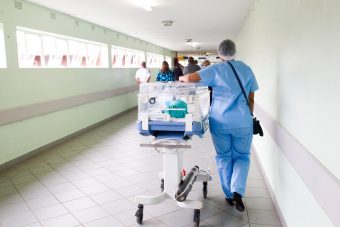
Modern medical facilities are some of the most complex buildings ever developed. Building designers and managers must balance a host of competing demands, including the need to be more cost-efficient in energy and resource use while still delivering resource-intensive medical treatments.
Systems like ABB’s open-standard i-bus® KNX reduce staff workload by automating core building functions such as lighting, shutter control, heating, ventilation, security, and energy management. ABB has delivered a key component of building automation, lighting management, to the new Calvary Adelaide Hospital, the largest private hospital in South Australia.
The modern 12-story hospital has been equipped with the latest ABB i-bus KNX® smart building technology. The hospital opted for the ABB i-bus® KNX system for all lighting control and monitoring in the building. Based on the worldwide KNX standard, ABB’s i-bus® KNX solution features intelligent and integrated building control for easier lighting management and increased flexibility, security, economic efficiency and convenience.
More:
With more than 1,200 KNX devices in the hospital, this is the largest project of its kind in the Southern Hemisphere. The solutions connect all of the building’s lighting and energy systems, allowing them to be automated or controlled at the touch of a button. With this smart building technology, the hospital is estimated to save up to 60 percent of energy costs.

The chosen lighting technology and control play a critical role in the cost structure of hospital maintenance, given the countless number of lighting points in patient rooms, research facilities, hallways, waiting rooms, laboratories and lobbies – all requiring lighting that best serves their purpose.
For Calvary Adelaide Hospital, the ABB i-bus® KNX, coupled with DALI (digital addressable lighting interface), gives hospital personnel and maintenance staff full command of the lighting functions. All of these functions can be managed automatically according to a schedule, sunset or sunrise, or presence of people, or by the touch of a button. This level of controllable lighting system is key to energy saving, with the additional benefit of increased comfort and safety.
ABB’s i-bus® KNX solution integrates the hospital’s lighting and energy metering to interface with the building management system (BMS) and Nurse Call system. This provides lighting automation and control critical for effective lighting, operational efficiency and safety. This interface enables the lighting and heating/cooling systems to work in unison, so as lighting sensors detect the movement of people and turn lights on, it triggers the heating/cooling system to respond accordingly.

An important challenge for hospitals is to reduce operational costs without adversely affecting patients. Studies have shown that KNX can result in energy savings of up to:
-10 percent in time switched (for example, automatically turn off lights in the evening)
-20 percent as a result of presence detection (lights turned on only when a person is detected)
-40 percent in presence and brightness detection (the system detects the level of sunlight to regulate how much lighting is required)
-50 percent in constant brightness control (the system maintains a constant level of light based on the level of natural brightness)
Patient rooms can be automatically configured to respond to individual needs, saving staff time while maintaining high-quality service.
Calvary Adelaide Hospital’s focus on state-of-the-art light management for buildings is just one example of how ABB solutions bring operational efficiency to medical facilities by understanding the facility’s individual needs, and bringing together a range of solutions seamlessly to deliver on key objectives.
Source: ABB



